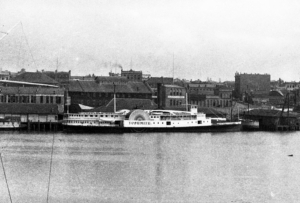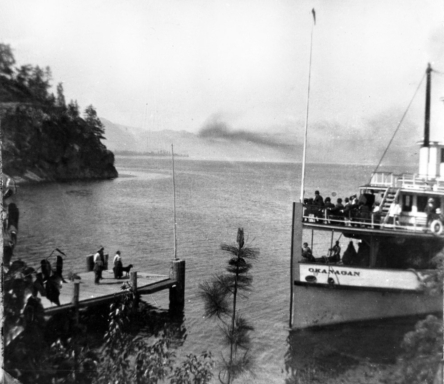The Greatest Contributor to Marine Transportation in British Columbia
an essay by Brian Wilson. Archivist © 2016
Captain James William Troup, steamer captain, river pilot, talented ship designer and successful business man, shaped the future of the marine world of our province at the turn of the century. He had a hand in the building of every CPR vessel in B.C., from the luxurious Princesses to tug and dredge.
Capt. Troup was a native of Portland, Oregon and a riverboat Captain since age 19. His first British Columbian ship was the Yosemite, a side-wheeler that ran from Victoria to New Westminster.  The Yosemite was part of a fleet run by John Irving.
The Yosemite was part of a fleet run by John Irving.
Irving had been made manager of the Canadian Pacific Navigation Company and found the Yosemite idle in Oakland California in 1893. On the urging of Governor Douglas and Colonel Moody, Irving added this ship to those he ran up the Fraser River, the S.S. William Irving, S.S. Reliant, and S.S. R.P. Rithet.
Troup skippered this ship until he joined Kamloops businessman J.A. Mara, running his ships on Shuswap Lake during the building of the C.P.R. He captained the steamers Pearless and Spallumcheen between 1884 and 1885.
James Troup left B.C. to return to the U.S. to be superintendent of the Oregon Railway and Navigation Company steamer operations. But Mara remembered him as a skilled commander of his trade and convinced him to join his steamer operations on Arrow and Kootenay Lakes.
Troup never looked back. He devoted his life to building innovative steamers, first on the Lakes of Central B.C., then on the Pacific coast.
Troup’s first challenge was to design a replacement for the steam scow, Dispatch. He established a shipyard at Revelstoke and began  construction of a small steamer, Illecillewaet. He didn’t just start nailing boards together, but studied the weather, water levels and river channels. He needed to deal with ice jams and shifting sandbars like never before. To deal with times of low water levels, he adopted the stern-wheel to operate in shallow water. With the instant success of this little ship, the Columbia and Kootenay Steam Navigation Company directors notified James Troup that he had a free hand to construct similar ships to run its freight routes to the Kootenay gold fields.
construction of a small steamer, Illecillewaet. He didn’t just start nailing boards together, but studied the weather, water levels and river channels. He needed to deal with ice jams and shifting sandbars like never before. To deal with times of low water levels, he adopted the stern-wheel to operate in shallow water. With the instant success of this little ship, the Columbia and Kootenay Steam Navigation Company directors notified James Troup that he had a free hand to construct similar ships to run its freight routes to the Kootenay gold fields.
But Troup had an idea for a superior design taken from his years on the Columbia River out of Portland. He contacted a family of shipbuilders, Thomas Bulger and sons James and David, from Portland to assist in creating his innovative designs. They arrived at Nakusp in 1894 to help Troup construct a shipyard capable of constructing larger vessels. They began building a 171 foot by 33 foot luxury sternwheeler soon after.
Captain Troup had experienced poor designs in his past and was experienced in the theories of vibration fatigue, roll, pitch and yaw as it related to sea worthiness. His ideas for lake navigation and all its unusual problems could be lessened with a vessel that had a set centre of gravity that allowed a shallow draught ship to operate smoothly in rough waters. To control bowing and warping of long hulled designs he pulled the frames under tension both fore and aft and side to side. He used a series of hog-posts from the lower hull to high above the deck to synch this tension. No matter how flat-bottomed his ships were, they moved gently side to side and never heeled over.
On July 1, 1895, the Columbia and Kootenay Steam Navigation Company launched the Nakusp to serve Arrow Lakes from Arrowhead to Robson. Fast and sleek, this beautiful vessel was one of the first with an electric lighting system to the delight of those on board and off.
the first with an electric lighting system to the delight of those on board and off.
Unfortunately, the S.S. Nakusp had a short life. She burned and was lost at Arrowhead in 1897.
But the design of the vessel opened the floodgates for fleets on all interior lakes, Kootenay, Slocan, Arrow and Okanagan as well as the Stikine River off the north coast. Captain Troup continued to act as architect for most construction even after C.P.R. purchased C&KSN in 1897. Ships rolled off the ways at Nelson, Nakusp and Okanagan Landing on a regular basis. Troup continued until 1901 when he was made superintendent of CPR’s newly acquired fleet operated by the Canadian Pacific Navigation Company.
James Troup took over the operations of 15 ships plying the coast and river systems. CPR entrusted Troup with evaluating efficiency; after all, some of the ships were 40 years old. He began by looking at routes not serviced or under serviced from Georgia Strait to the Alaska Panhandle. He soon convinced CPR that a new fleet of coastal vessels was needed. They were to be designed to carry passengers and freight in a comfortable and efficient manner as well as being fast and beautiful.
CPR was already running a fleet of ocean liners named “Empresses” so the new coastal fleet was to be named the “Princesses.” (It is noted that the first “Princess” was the sidewheeler Princess Louise, part of the CPN purchase of 1901. She was sold in 1906 and became a barge for a lumber company.)
Troup needed to start this marine ball rolling and chose to purchase a liner already in service on the Chinese coast. Built in 1888 by Hawthorne, Leslie and Company of Newcastle-on-Tyne as the “Cass”, this 1,708 ton steamer spent 13 years in the Far East but remained in relatively good condition. When she arrived in Vancouver, she was named the “Ha-ting.” She became the first Princess and was named after the wife of the Duke of Cornwall and York, Princess May.
She was immediately put to work on the Alaska route where she proved a real boon to the fleet. She could maintain 15 knots efficiently. Even before her refit she had 60 first class staterooms and ample second class accommodation.
Troup had plans for an even larger vessel that could maintain 20 knots. In early 1901, he opened bids on the next in the fleet, Princess Louise.
But let’s not delve into the mundane successes of 30 ships named Princess of the CPR coastal fleet; let’s follow the fate of the Princess May. The Princess May ran aground on August 5, 1910.
The Princess May departed from the port of Skagway in Alaska with 68 crew, 80 passengers aboard and a huge load of gold from Alaska mines. She was powering down the Lynn Canal at 10 knots through a thick fog when the hull hit an underwater reef off the north end of Sentinel Island. The ship’s weight and speed meant that its momentum drove it hard up onto the rocks. The reef tore through the hull and began flooding the engine room.
The Princess May was equipped with a wireless Morse code transmitter; however, it had not been fitted with auxiliary batteries, meaning that if the engines stopped turning the dynamo, the
 power to the transmitter would be immediately lost. The wireless operator, W.R. Keller, knew this. He was unable to transmit an SOS before power was lost to the ship, and so he ran below decks and found a functioning electrical connection with the engine room’s lamp battery. Using this power, he was able to send a short message that simply said, “S.S. Princess May sinking Sentinel Island; send help.”
power to the transmitter would be immediately lost. The wireless operator, W.R. Keller, knew this. He was unable to transmit an SOS before power was lost to the ship, and so he ran below decks and found a functioning electrical connection with the engine room’s lamp battery. Using this power, he was able to send a short message that simply said, “S.S. Princess May sinking Sentinel Island; send help.”
Captain McLeod landed all passengers, mail and the gold shipments onto the island at low tide. All aboard were picked up by the Princess Ena and taken to Juneau.
Amazingly, less than a month later the Princess May was refloated by Captain W.H. Logan and his salvage crew. He brought in Seattle based salvage tug, Santa Cruz, to assist. In total, 120 steel plates along the hull had been damaged with the largest hole being over 50 feet long. Sliding ways were built and much rock was blasted away. On September 3rd, the Santa Cruz, assisted by tug William Jollife, were able to refloat the ship. Thirty hours after salvage, one of the heaviest gales of the season occurred that had the power to destroy the stranded vessel. This was the 32nd successful salvage for Captain Logan.
The ship was repaired at a cost of $115,000 and resumed her routes by spring 1911.
Troup had to endure other tragedies in the Lynn Canal route to Skagway. The worst was the sinking of the Princess Sofia on Vanderbilt reef in 1918. All aboard were lost.
James continued to enhance the coastal service for CPR until his retirement in 1928 at age 73. The Victoria Daily Times noted on his retirement: His initiative and boldness may be ascribed by the splendid fleet of vessels operated by the company out of Victoria and Vancouver. Because his judgement and vision always have been justified by the result, and because these qualities went hand and hand with the unwearied zeal, loyalty and enthusiasm, he had in the fullest measure the confidence of the directorate of the Canadian Pacific Railway Company, and his recommendations were unvaryingly approved. One of the most convincing commentaries on the relations between him and his company is in the fact that he is eight years of age beyond the limit set in the company’s rules for retirement of its officials. It is not easy for those who know Captain Troup and who are struck by his physical and mental vigour and youthful appearance, to realize that this is a correct statement of the case.
Captain James Troup died on November 30, 1931.
There is no greater tribute to James Troup’s life in British Columbia than the preservation of the 102 year old sternwheeler, S.S. Sicamous, restored at the Marine Heritage Park in Penticton, B.C.





